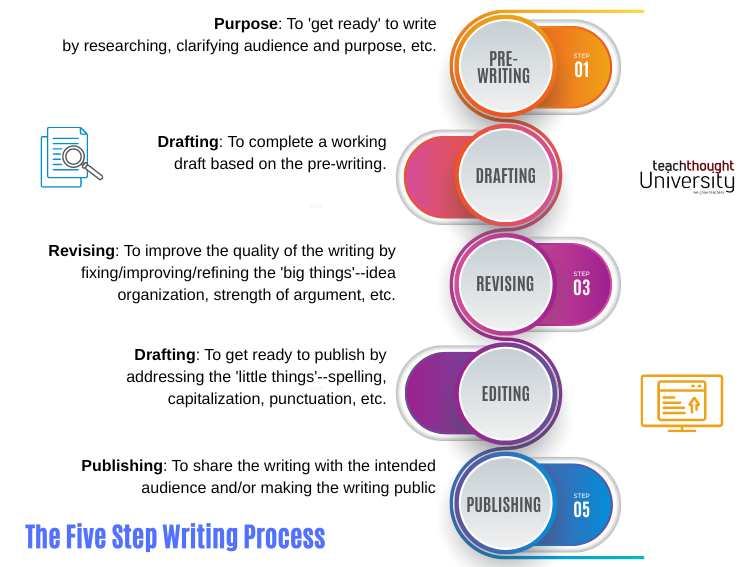What is the writing process?
The writing process is a sequence of strategies to plan, write, and ultimately publish a polished, accurate, well-organized piece of writing.
It is a critical practice–and concept–for students to master. As a sequence of ‘priorities’ (preparing to write, writing, then refining and sharing the work), the writing process is complex, with a variety of strategies within each step to accomplish its respective goal.

What Are The Five Steps Of The Writing Process?
by TeachThought Staff
1. Pre-writing
If you only teach students one thing about writing, you could do worse than start with pre-writing. In the pre-writing stage of the writing process, students will do things like clarify their audience and purpose, research their topic, create concept maps and outlines, and more. As noted above, the big idea here is to ‘prepare to write.’
2. Drafting
The drafting stage is where students take their pre-writing and, using it as a kind of map or scaffolding, actually produce a finished piece of writing. The name of the stage, however (draft) implies that the writing isn’t finished even when the draft is complete. There is still work to do!
See also What Are Literature Circles?
3. Revising
Revision is where students address ‘big things’: too little or too much information, unclear thesis statements, a lack of idea development, not accomplishing the purpose of the writing, disorganized thematic development (in essay writing), a lack of audience awareness, and more.
The better the pre-writing, the less work students typically have to do here. Rushed or incomplete pre-writing (they can think of it as planning before a trip or making a grocery list before going to the grocery) means more time will be spent reorganizing, rearranging, and sometimes even rewriting the draft altogether.
CREAM is a useful strategy here. Students can ask, ‘What can I Combine, Remove, Exchange, Add, or Move to improve the quality of my writing?’
See also The Relationship Between Reading And Critical Literacy
4. Editing
Once revision is complete, students can focus on the ‘small stuff’: diction, sentence structure, spelling, punctuation, etc. This step essentially polishes the writing, readying it for publication to its intended audience to accomplish its intended purpose.
5. Publishing
In many classrooms, the audience is simply the teacher and so ‘publishing’ means turning in the work. However, more authentic learning experiences invite students to address real-world problems or opportunities with authentic audiences to achieve authentic purposes. In short, authentic writing assignments should be written as if they will leave the classroom.
In many cases, actually ‘leaving the classroom’–through publishing the writing, for example–isn’t practical, appropriate, or authentic. Publishing personal writing on a blog might make sense in some cases, but in others, rather than ‘authentic,’ it could be inappropriate and clumsy at best and, at worst, unsafe.